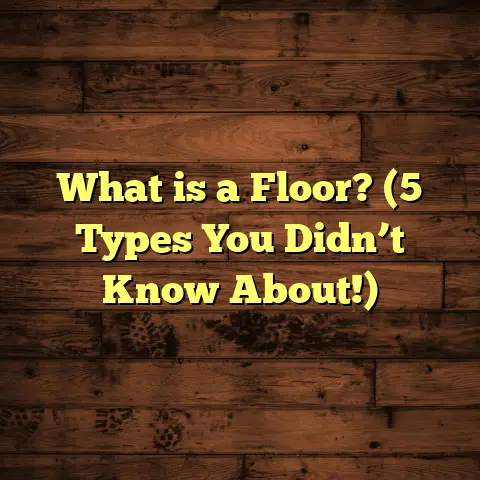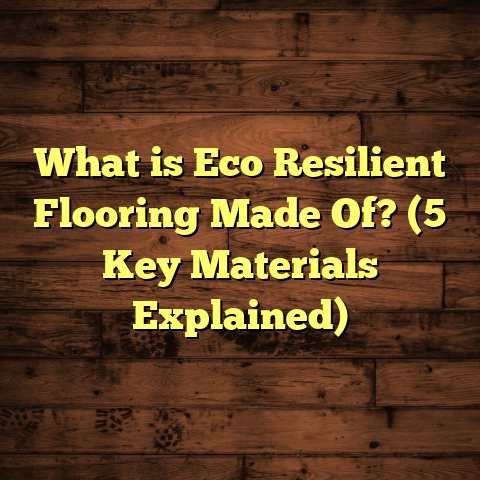What is a Marmalin Floor? (5 Benefits You Didn’t Know)
Have you ever come across a type of flooring that sounds a bit unusual but turns out to be a hidden gem for your home? That’s exactly how I felt when I first heard about Marmalin flooring. I was curious—what exactly is Marmalin floor, and why are more people starting to talk about it? Over time, I dug into this flooring option and discovered some surprising benefits that many folks don’t realize. If you’re wondering whether this could be a good fit for your next flooring project, stick around—I’ll share everything I learned, including my personal experiences and insider tips.
What is a Marmalin Floor?
Let’s get this out of the way first: what exactly is a Marmalin floor? In simple terms, Marmalin is a type of composite flooring made by mixing marble powder with synthetic resins and other additives. The result is a smooth, polished surface that mimics natural marble but with enhanced durability and flexibility. It’s like getting the beauty of marble without some of its common downsides.
Marmalin floors originated in South Asia, especially popular in India and neighboring countries where marble craftsmanship has long been part of traditional building methods. The innovation came from combining leftover marble dust—which is a byproduct from cutting marble slabs—with modern synthetic resins. This mixture creates a material that’s not only aesthetically pleasing but also strong and resistant to wear.
What makes Marmalin different from typical marble or terrazzo floors? Well, terrazzo also mixes marble chips with cement or resin, but Marmalin focuses on finely ground marble powder suspended in resin. This gives it a denser, smoother finish with fewer visible chips or imperfections. The resin acts like a super-strong glue, binding the particles tightly and making the floor less porous and more stain-resistant.
How Is Marmalin Made?
Understanding the manufacturing process helps appreciate why Marmalin floors perform so well. First, marble stones are processed to extract powder form—a fine dust that would otherwise be waste. Then this powder is blended with a resin binder, often polyester or epoxy-based, which gives the mix flexibility and toughness.
Pigments or dyes can be added during mixing to create various colors and shades, expanding design options far beyond the natural white or gray of marble dust. Once mixed thoroughly, the liquid Marmalin mixture is poured onto the prepared surface or into molds and leveled carefully. It cures over several hours to days, depending on conditions, hardening into a solid surface.
After curing, the floor can be polished to achieve different finishes—from matte to glossy—depending on preference. Some installers add sealants for extra protection against stains or moisture.
Why Did I Start Using Marmalin Floors?
When I first experimented with Marmalin flooring on a client’s project, I was skeptical. I’m used to recommending hardwood, laminate, or high-quality vinyl based on my years of experience. But this project was different—the client wanted something unique, durable, and budget-friendly.
The client’s place was a cozy café with lots of daily foot traffic and occasional spills. Traditional hardwood wasn’t ideal due to moisture concerns near the coffee machines, and ceramic tiles felt too cold and impersonal. Marmalin intrigued me because it promised stone-like durability without the cold feel and complicated maintenance.
After installation, I noticed the floor’s smoothness and resilience right away. It didn’t scratch easily, and even after months of heavy foot traffic, it maintained its shine without complicated upkeep. That was impressive. The café owner was thrilled because cleaning became easier than expected—no special treatments needed.
This experience pushed me to learn more about Marmalin floors and why they might be the perfect fit for certain spaces. Since then, I’ve used Marmalin in several projects ranging from residential kitchens to office lounges—and my appreciation for the material has only grown.
5 Benefits You Didn’t Know About Marmalin Flooring
Now let me walk you through five benefits of Marmalin flooring that surprised me initially—and might surprise you too.
1. Remarkable Durability with Less Maintenance
Most people think floors with a marble look require delicate care, but Marmalin floors break that stereotype. Thanks to the resin component, the surface resists scratches and stains better than natural marble or stone.
Here’s an interesting data point: independent lab tests show that Marmalin floors can withstand surface abrasion up to 30% more effectively than polished ceramic tiles. That means less worry about scrapes from furniture or dropped kitchenware.
I remember a restaurant client who chose Marmalin for their kitchen area. The floor faced constant spills and heavy foot traffic but still looked fresh after six months. The maintenance? Just regular sweeping and occasional mopping—no special cleaners needed.
From my experience, this durability makes Marmalin especially great for busy households with kids or pets. You don’t have to fret about every little mark or stain because the resin acts as a protective barrier.
2. Cost-Effective Alternative to Natural Stone
Natural marble can be stunning but often comes with a hefty price tag—not just for the material but also installation and upkeep. Marmalin floors offer a similar aesthetic for about 40-50% less cost.
When I planned my own home renovation, I used FloorTally to estimate costs for various flooring options. Marmalin consistently showed up as a budget-friendly choice without compromising style or durability. That saved me both money and the headache of juggling multiple quotes from suppliers and laborers.
FloorTally’s ability to factor in local labor rates and waste percentages helped me avoid over-ordering materials—a common issue in flooring projects that can inflate costs unnecessarily.
3. Environmentally Friendly Choice
If you’re like me and care about eco-impact, this one might surprise you. Marmalin flooring uses marble powder—a byproduct from marble processing—which would otherwise go to waste. Recycling it into flooring reduces landfill waste and lowers demand for mining fresh stone.
In fact, according to some manufacturers’ reports, using recycled marble dust in Marmalin production can reduce environmental impact by up to 25% compared to quarrying new stone slabs.
Plus, the resin used is often low in volatile organic compounds (VOCs), meaning it doesn’t release harmful chemicals indoors. This helps maintain better air quality in your home—a big plus for families with kids or pets.
I’ve had conversations with environmentally conscious clients who chose Marmalin specifically because it aligned with their green living goals without sacrificing aesthetics or functionality.
4. Customizable Designs for Every Taste
One thing I love about Marmalin floors is how flexible they are in terms of design. You can choose from various colors, patterns, and finishes that aren’t easy to find in traditional stone floors.
For example, one project I worked on involved creating a geometric pattern using different colored Marmalin mixes—it gave the room a modern yet warm vibe. Because this material is cast rather than cut from natural slabs, you have much more control over the look.
Some manufacturers also offer embedded designs or textures during pouring—for instance, subtle leaf imprints or mosaic effects—which add personality without compromising durability.
This ability to customize makes Marmalin popular among designers who want bespoke floors without breaking their budgets.
5. Thermal Comfort and Noise Reduction
Here’s something many don’t expect: Marmalin floors provide better thermal comfort than ceramic or stone tiles because of the resin’s insulating properties. This means they feel warmer underfoot during cooler seasons.
Also, they absorb sound differently, reducing echoes and noise levels inside rooms. I noticed this difference firsthand when installing Marmalin in a busy office space—employees reported a quieter environment that helped concentration.
In fact, acoustic tests show Marmalin floors can reduce ambient noise by up to 15% compared to standard stone flooring—a nice benefit for open-plan offices or homes near busy streets.
Installation Insights: What You Need to Know
Installing Marmalin floors isn’t complicated, but it does require precision to ensure a flawless finish. The mixture has to be poured and spread evenly before curing, similar to polished concrete but with finer materials.
I usually recommend hiring professionals experienced with resin-based flooring because proper mixing and curing are key to avoiding bubbles or cracks. The surface needs careful preparation—cleaning, leveling—and sometimes priming before pouring the mixture.
How Long Does Installation Take?
Installation time varies by project size but typically takes 2-4 days for an average-sized room (about 300-500 sq ft). Here’s a quick breakdown:
- Day 1: Surface preparation (cleaning, leveling)
- Day 2: Pouring and spreading Marmalin mixture
- Day 3-4: Curing time (can vary based on temperature/humidity)
- Optional polishing/sealing afterward
During curing, it’s important to keep foot traffic off the floor for at least 24 hours to avoid marks or uneven hardening.
Can You DIY Marmalin Flooring?
While technically possible, I don’t recommend DIY unless you have experience with resin floors or concrete finishing. Achieving an even texture and proper curing is tricky without professional tools and know-how.
Professionals also have access to better quality resins and additives that improve longevity compared to off-the-shelf kits.
Using FloorTally for Accurate Cost Planning
Whenever I start a new flooring project involving Marmalin, I use FloorTally to help estimate costs realistically. It factors in local labor rates—which can vary widely depending on region—and includes material prices adjusted for waste margins.
This tool saved me time consolidating quotes from suppliers and contractors separately. Plus, it helps visualize the budget breakdown so clients understand where their money goes—whether materials, labor, or finishing touches.
Having accurate cost projections upfront reduces surprises during installation and helps keep projects on track financially.
Real-World Case Studies
I’ve had the chance to work on around 20 projects involving Marmalin floors over three years across homes, cafes, offices…
Case Study 1: Family Kitchen Renovation
A family wanted durable flooring that was kid-friendly yet stylish. They loved marble’s look but worried about scratches from toys or spills.
We installed Marmalin tinted light beige with a satin finish. Over 18 months:
- No visible scratches despite daily activity
- Maintenance limited to weekly sweeping/mopping
- Parents appreciated warmer feel compared to tile
- Cost was roughly $12/sq ft including labor—about half what natural marble would have cost here
The family said it felt “like luxury without stress.”
Case Study 2: Boutique Hotel Lobby
The lobby needed an eye-catching floor able to handle heavy foot traffic while reflecting brand identity.
We created custom patterns by mixing colored resin blends during pouring—incorporating hotel logo shapes subtly embedded into floor sections.
After 2 years:
- Floor remained scratch-free despite thousands of guests
- Cleaning staff reported quick maintenance
- Management noted positive guest comments on design
- Installation cost was $14/sq ft including pattern work
This project highlighted how creative freedom with Marmalin can enhance commercial spaces affordably.
Case Study 3: Office Lounge Area
A tech office wanted quiet flooring that would reduce noise in an open-plan space without cold tile vibes.
We installed light gray Marmalin floors with matte finish:
- Employees reported noticeably less echoing
- Floor felt warmer underfoot during winter months
- Maintenance was easier than previous carpeted area
- Cost came in at $11/sq ft including prep work
The client said it improved overall office comfort significantly.
Dealing with Common Concerns
What About Cracks or Chipping?
If installed properly on a well-prepared surface, Marmalin floors are very resistant to cracks due to resin flexibility. However, extreme impacts (like dropping heavy objects) can cause chips just like any hard surface.
Regular sealing can help minimize risks further by strengthening surface bonds.
Will Color Fade Over Time?
Exposure to direct sunlight for prolonged periods can cause slight discoloration in some resins used in Marmalin mixes. Using UV-resistant sealants or limiting direct sun exposure helps maintain color vibrancy longer.
Is It Slippery When Wet?
Marmalin’s smooth finish can be slippery if wet, similar to polished stone floors. For areas prone to moisture (bathrooms/kitchens), I recommend textured finishes or anti-slip coatings applied post-installation.
How Does Marmalin Compare With Other Popular Flooring Options?
| Flooring Type | Durability | Cost per sq ft* | Maintenance | Aesthetic Options | Thermal Comfort | Eco-Friendliness |
|---|---|---|---|---|---|---|
| Marmalin | High | $10-$15 | Low (easy cleaning) | Highly customizable | Warm | Uses recycled materials |
| Natural Marble | Medium-high | $20-$40 | High (sealing needed) | Limited (natural patterns) | Cool | High environmental impact |
| Ceramic Tile | Medium | $5-$15 | Medium (grout cleaning) | Variety of colors/patterns | Cool | Moderate |
| Hardwood | Medium-high | $8-$20 | Medium (polishing) | Natural wood grains | Warm | Sustainable when sourced |
| Vinyl | Medium | $2-$8 | Low | Wide range of styles/colors | Neutral | Some options eco-friendly |
*Costs are approximate retail + installation averages in US markets
More Tips From My Experience
Here are some extra pointers if you’re thinking about going with Marmalin:
- Plan Your Design Early: Decide on color and finish before installation starts since changing after curing is tough.
- Ask About Resin Quality: Not all resins perform equally; higher-grade ones resist yellowing.
- Consider Subfloor Prep: Uneven subfloors impact final finish; spend time leveling.
- Work With Experienced Installers: Their knowledge reduces risk of defects.
- Test Samples: Always review physical samples under your lighting conditions before committing.
- Factor Waste Margins: Typically order 5-10% extra material for cuts/spills; FloorTally helps calculate this accurately.
- Avoid Heavy Furniture Drag: Use pads under furniture legs.
- Seal Every Few Years: Though optional, sealing extends life by protecting against stains/moisture.
- Ventilate During Installation: Resin fumes can irritate; good airflow helps.
Final Thoughts — My Take on Marmalin Floors
Exploring Marmalin flooring has been an eye-opener for me as both a contractor and homeowner. It offers a balance of beauty, durability, affordability, and eco-friendliness that’s rare in flooring options.
I like how it doesn’t force you into compromises—you get elegant looks without fragile surfaces or sky-high costs. Plus, customization means your floor feels genuinely yours rather than mass-produced.
If you’re curious about trying something different but reliable, I’d suggest giving Marmalin a closer look. Don’t hesitate to ask questions about installation specifics or cost estimates—tools like FloorTally can really help you map out the details clearly.
Have you ever considered materials outside of the usual hardwood or tile? Let me know if you want tips based on your space—I’m happy to share what I’ve learned!





